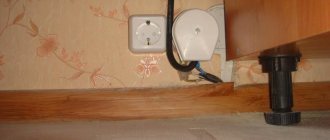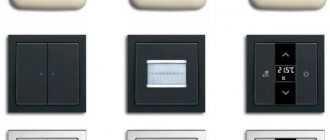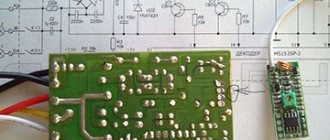Wireless light switch is a multifunctional accessory for controlling home lighting. It turns the lighting on/off by sending a signal “over the air” to a receiver or relay. To install such a device, you do not need to lay many meters of wiring and ditch walls, and it can be placed in any convenient place (within the reach of actuators).
Design and principle of operation
The wireless switch structurally consists of two elements:
- signal transmitter;
- receiver.
Together they provide remote control of the lighting system.
The connection diagram for the wireless switch is simple:
- the transmitter is installed in the selected location;
- the receiver with the relay is placed in the light source or next to it;
- Power is supplied to the input from the home electrical network, and a load is connected to the output.
How to connect the receiver to the transmitter is described in the attached instructions: usually just press the pairing key, but in the case of “smart” gadgets, sometimes you need to link them via the Internet and the smart home application.
Receiver
The receiving part is an over-the-air relay. When a command arrives at the receiver, the relay is activated and closes the contacts, turning on the light. Disconnection occurs on another corresponding command.
The board has two groups of contacts - input and output. The first is usually designated by the word Input, the second by Output. This hint is given to avoid incorrect joining. The board itself is no larger than a matchbox and is easily hidden in the body of a chandelier or lamp.
The relay is installed as close as possible to a lamp or other lighting device, but always within the “visibility” of the signal from the transmitter. At the same time, such gadgets are sometimes placed directly in the junction box, if technically possible.
Control is carried out from a remote control, computer, tablet or smartphone via a supported wireless communication protocol.
Transmitter
This device must be mobile, so most transmitters operate on autonomous power sources - batteries and rechargeable batteries, or have kinetic generators to convert the keystroke pulse into current.
An important parameter is coverage area. It depends on the technology used and the configuration of the room. Inexpensive models have a range of action of 20–50 meters, while advanced ones are capable of “piercing” a radius of up to 350 m. But they also cost significantly more, being intended for large houses and other premises with a large area.
There are models on sale designed for “smart homes” that can not only turn the lights on and off, but also change the level of illumination. To do this, they are equipped with a special regulator - a dimmer. It controls the supply of power to the lighting fixture, changing the brightness by reducing or increasing the power. Dimmers interact effectively with both modern LED lamps and classic incandescent lamps.
Recommended reading: Find out what a smart light switch is and what are the benefits of using it.
Understanding the infrastructure
In practice, I have come across several approaches to controlling outdoor lighting: regulated switching on and off by operating personnel, the use of time relays, twilight sensors, photo relays and astronomical relays.
The use of astronomical relays is probably one of the most interesting solutions. Their work is based on determining the times of sunrises and sunsets in a certain geographical location. During sunset the lighting turns on, during sunrise it turns off. Typically, when configuring such relays, it is possible to set temporary adjustments to speed up or slow down the action of the relay. Making such adjustments allows you to turn on (turn off) the lighting a few minutes later than sunset or earlier than dawn.
The system we are modernizing works according to a similar scheme. A freely programmable logic controller (PLC) acts as an astronomical relay. Via RS485 line, the PLC controls proprietary I/O modules that are installed in different buildings. The system is controlled and configured using SCADA and an OPC server installed on one of the machines on the Ethernet network to which the PLC is connected. All software used is proprietary.
What types of wireless switches are there?
The operating principle of remote lighting controllers is similar, and they are structurally similar in many ways. But there are also differences. There are varieties based on the type of control:
- wireless touch light switch;
- button;
- switch with remote control;
- mixed type.
Another classification is based on the number of paired devices. Budget models support 1–2 receivers, advanced ones “can” control 7–8 devices or more.
Switches are also distinguished by the presence or absence of a dimmer.
An important difference is the built-in functionality. Basically, this type of gadget simply turns the light on and off at the owner’s command, and models with a dimmer control the intensity. But expensive options come with features such as:
- delay timer. The device will not work immediately after pressing the button, but a little later;
- multi-channel controller. The device operates simultaneously via several communication channels (for example, individual radio frequencies), interacting with several executive components at once. The latter can be distributed among different rooms and floors;
- presence of a touch panel. This design solution avoids wear and tear on mechanical buttons. To activate, just touch the touch surface;
- Wi-Fi support. This is a very important function, thanks to which devices can be controlled from a smartphone, tablet, home PC, and even via the Internet if there is a gateway.
The set of functions directly affects the cost: the more features, the higher the price.
By type of control
Let's take a closer look at the classification of switches by control.
Mechanical
They are very similar to the usual wall ones. The control mechanism looks like regular keys or a button. By pressing it, the user initiates sending a signal to the relay. Switching to the “off” position instructs the device to send a shutdown command.
One light source is assigned to each key. A two- or three-key device is capable of controlling the corresponding number of sources, but it will cost slightly more.
Sensory
As already mentioned, these gadgets are controlled via a touch panel. To activate it, simply touch it.
With remote control
In this version, signals are sent from a special remote control. This subtype includes models controlled via Wi-Fi.
In the case of the remote control, the range of action is approximately 25 meters, if there are no thick walls or other obstacles in the room. If they are present, the radius narrows to 3–5 meters, and at a line of sight distance, on the contrary, it can increase to 50 m.
You can expand your coverage area by installing repeaters. This also applies to versions with Wi-Fi.
Ways to control light remotely
A convenient and high-quality system for the correct use of lighting equipment can be organized in different ways. Most often, for this purpose and to control all lighting devices, one controller or remote control is used.
The maximum number of functions represented by lighting control is included in the smart home system. Any modern wireless lighting system can operate using radio wave, infrared and pulse signals.
To control the system, different options are used, which can be represented by wall controllers, light switches using remote control, personal computers, as well as smartphones - mobile phones.
Controlling the lights in your dacha using your phone
The most common methods of regulating various lighting devices include using a telephone or smartphone, and the process itself is carried out in the following ways:
- GSM module in the form of sending SMS and calls;
- Wi-Fi application.
Lighting control involves turning lamps off and on, adjusting lighting intensity, and setting a timer for various lighting fixtures.
Working principle of wall controller
The technically simplest option for remote control is a standard wall controller. In appearance, the wall controller is very similar to a regular switch and is used to send a signal to turn lighting equipment on and off.
This type of device is a modern automatic machine that controls any lighting fixtures in strict accordance with a specific algorithm determined by the program. Information is supplied to the wall controller from various devices, which can be represented by a remote control, sensors or buttons in manual mode. The controller is programmed using a standard computer keyboard and LCD display.
The sensors are distinguished by their accuracy; some models have ultrasonic indicators that increase recognition efficiency. Properly installed photovoltaic cells help control lighting brightness. The process of turning off and turning on occurs automatically.
Remotely turn on and off the light from a computer
Computerization of the process of controlling garden lamps is a modern and convenient option. As a rule, in the “Smart Home” home remote automation system, the interface for controlling lighting devices can be implemented using special software installed on a personal computer, or done through a browser, using a special web server that broadcasts a pre-configured page.
In the process of controlling lighting fixtures from a personal computer, the full functionality of the entire system is available, represented by turning on and off absolutely all light groups, as well as adjusting brightness and launching various backlight or lighting scenarios. Correct implementation of all these possibilities requires connecting lighting devices using a special programmable device located in a special panel.
If the possibility of installing a shield is completely absent, then the lighting devices can be controlled from a personal computer using programmable radio relays and special dimmers that operate via the z-wave protocol.
Another acceptable and quite convenient option is to use special lamps with a radio module in standard lighting devices. Such a system is well compatible with special controllers that will act as a web server. Lighting devices and controllers controlled via a personal computer, produced in the line of ready-made iNels kits, have proven very good.
How to connect lighting control from a smartphone (video)
Radio-controlled and infrared remote controls
Any set of wireless radio-controlled lighting must be equipped with a special radio transmitter, which transmits a signal coming from a special command device via a radio channel. The signal range indicators are directly dependent on the features of a particular model, but the maximum values are a third of a kilometer. Installing an antenna allows you to increase the radius to 2.5-3.0 km.
To combine all installed radio transmitters into a single system, a control station is used to help control the functioning of the luminaires. The control station is connected to computers on which the initial settings must be set and recorded. Further operation can be carried out in a completely autonomous mode.
Wireless lighting based on infrared signals is used in outdoor lighting. The operating principle is similar to that of a TV remote control. To amplify the signal, a special device can be installed that converts the infrared signal into radio waves, which allows the transmission of commands over long distances.
Organization of remote control of street lighting in a summer cottage
The external lighting regulation and control system optimizes the street lighting of the local area at night. It is very important to properly organize lighting using a systematic set of devices that can be represented by modern automated control systems.
In this case, the lighting mode of the lighting device is controlled and the state of the system is monitored. Also, the owner of a personal plot has an excellent opportunity to increase the energy efficiency of outdoor lighting. The advantages of such control include working in autonomous mode, completely eliminating the human factor, minimizing energy losses and increasing the efficiency of the backlight.
Features of self-installation of a remote lighting control system
Overly complex circuits will require sufficient knowledge in the field of electronics, as well as the ability to independently calculate loads and correctly create competent electrical circuits. In order to independently install a remote control and lighting control system, you must purchase a ready-to-install block or panel “PIC”, “AVR” or “ACUHO-GSM” from specialized retail outlets.
The cost of such equipment is determined by the principle of operation, as well as the main capabilities during operation. It should be noted that systems operating using radio waves are an order of magnitude more expensive than infrared circuits. If knowledge in the field of electronics and installation of electrical appliances is completely lacking, then it is advisable to entrust the installation of a remote control system to professionals.
If you need to control three or four lighting fixtures, it is recommended to purchase a ready-made kit with a remote control and special electrical sockets. This affordable option is easy to use and does not require complex special installation.
Where to buy wireless switches
You can purchase wireless switches either in a specialized store or online in an online store. In the second case, the budget option for purchasing products on the Aliexpress website deserves special attention. For some switches there is an option for shipment from a warehouse in the Russian Federation; they can be received as quickly as possible; to do this, when ordering, select “Delivery from the Russian Federation”:
| Universal relay with a set of switches for wireless control | AXUS smart wall switch with Wi-Fi | Smart Wall Switch with Wi-Fi |
| Switches with remote control EsooLi | Wireless touch switches SMATRUL | Wireless switch with receiver |
Where are they used?
Wireless switches are used wherever it is necessary to install a new or move an old switching device, but due to some circumstances it is impossible to get by with classic wired options.
In difficult situations, it is possible to install such a gadget not only on the wall, but also, for example, inside a closet shelf, on a mirror, and so on. This does not affect functionality - the device will continue to function normally. This will help save space and not worry about the aesthetic side if, for example, the purchased accessory turns out to not match the overall style of the room. You can simply hide it.
A remote light switch will also come in handy in case of errors with the wiring. Now you don’t have to re-arrange everything, just place the “over-the-air” model in a convenient place, and the problem will be solved.
This class of accessories is gaining popularity in the field of wooden construction. Wiring in a wooden house requires special fire safety measures, and wireless devices help reduce the number of potentially dangerous cables. In addition, in the case of open wiring, the latter is more vulnerable to damage, and wireless-type modules largely eliminate the likelihood of breaks, short circuits and other troubles. Although the remaining wired communications still require protection measures.
An “air” switch will be a real salvation in houses with many rooms or rooms divided into locations with separate types of lighting. You don’t need to install many separate devices—it’s enough to get by with one or two (for example, multi-key devices) and associate them with the necessary lighting fixtures, and then activate the necessary segments as needed.
Another use case for wireless light switches is in renovated spaces. When the renovation is completed and the final coating has been applied to the walls (be it laminate, wallpaper, paint or something else), it can be difficult to add any functional electrical wiring components to the decor. Including the switch - this requires dismantling the finishing, gating and other manipulations. A wireless switch solves this problem - you just need to place it in the right place with a minimum of time and effort, and without harming the new interior.
The same applies to premises with historical value, where large-scale interventions and changes to the situation cannot be carried out. Remote switches can easily be “disguised” into furniture and objects and provide comfortable control of the lighting level.
You cannot do without a modern lighting control system in large commercial premises, conference rooms and other places with large areas. It will make it possible to turn on the lights throughout the entire territory from one device, including while outside the building. The same system allows you to track your status, and the most advanced models even have the function of counting the kilowatts spent.
Twilight
There are periods in the day called “twilight”. This is the time before sunrise and after sunset when the sky is partially illuminated by diffuse sunlight. There are three types of twilight: civil, navigational and astronomical. Civil twilight is defined as the period when the angle of the Sun below the horizon is from 0°50′ to 6°, navigational twilight is from 6° to 12°, and astronomical twilight is from 12° to 18°.
Navigational twilight is of greatest interest to us. It is during this period that the lighting becomes closer to night than to evening, so city streets need artificial lighting. Simply put, external lighting turns on at the beginning of navigational twilight (the Sun falls below -6°) and turns off at its end (the Sun rises above -6°). Of course, it is worth understanding that depending on weather conditions and in urban areas, switching on may be required before the Sun drops below -6° below the horizon.
A little more about astronomical relays.
When we discussed the operation of astronomical relays, we mentioned temporary adjustments that speed up or slow down the action of the relay. This time delay approach has disadvantages. As we found out, the illumination on the streets is mainly determined by the angle of the Sun relative to the horizon. In the same geographic location, the speed at which the Sun descends below the horizon varies throughout the year. Or, in other words, depending on the time of year, the duration of twilight changes and navigational twilight may occur later or earlier. Because of this, time delays in astronomical relays require periodic changes.
If you control the lighting based precisely on the actual position of the Sun, then there is no such problem.
A detailed and extremely visual story about the movement of the Sun was found on Youtube - How the sun moves across the sky (by daybit).
Advantages and disadvantages
A remote controlled light switch is convenient, modern and practical. Advantages of this class of devices:
- easy installation. There is no need to dismantle the trim, do gating and pull additional wiring;
- centralized control over all light sources within reach from one switch, remote control or computer/phone/tablet;
- possibility of remote control, including from outside the room/building;
- high operational safety. All devices consume minimal current and are not dangerous even in case of incorrect use or breakdown;
- for the most multifunctional models - additional features: work according to a schedule and triggers, remote access, integration into a “smart home”.
But there are also disadvantages:
- Battery-powered gadgets need to be replaced regularly;
- If a Wi-Fi connection scheme is used, the channel is very sensitive to the quality of the connection. A weak signal or a high level of interference (for example, a clogged airwave with many Wi-Fi gadgets) can seriously hamper the operation of the device and cause numerous “glitches”, even complete inoperability.
Advantages and disadvantages
The ability to control the light from a remote control or other control device has the following advantages:
- Availability of installation and connection.
- Smooth adjustment of lighting characteristics of lamps.
- Programming a schedule for turning the lights on and off, creating a “presence effect”.
- Optimization of energy consumption.
- Saving the working life of lamps.
Saving energy and extending the service life of lamps are the main advantages of a light control system Source avtcom.ru
- Turning on and off several lighting devices at the same time.
- Monitoring the safety of electrical appliances at home.
The disadvantages of systems for controlling lighting devices at a distance are manifested in the high cost of equipment and the influence of extraneous factors on the nature of their operation, for example, such as precipitation for outdoor devices, as well as the movement of warm air indoors.
Subtleties of choice
When choosing a device, you should consider some important characteristics. Among them:
- the type of light bulbs that the device can control;
- dimensions;
- appearance of the device (case color, material, shape, for mechanical ones - number of keys/buttons);
- operating voltage;
- wireless technology;
- number of interface channels;
- signal coverage radius, ability to work through repeaters;
- maximum operating load;
- rated current;
- operating frequencies;
- presence/absence of encryption;
- way of eating;
- type of control (buttons, remote control, sensor, all of the above);
- possibility of remote control from a smartphone, tablet or personal computer;
- if integration into a “smart home” is planned – the presence of such a function and supported intelligent systems;
- battery life declared by the developer;
- fastening method;
- price.
As you can see, it is advisable to start selecting a wireless switch already at the design stage of the room in order to buy the most suitable sample for specific conditions. But if a gadget is bought for a ready-made and finished house, room, or commercial property, the first place comes to cost-effectiveness, compactness, versatility and inconspicuousness (or a design that matches the interiors).
In addition, it is important to have a factory warranty and manufacturer service centers. They will make it easier to repair or replace a faulty device.
Sensors in a smart system
Sensors for smart lighting perform an important function - they activate the automatic switching on of lamps. Let's consider two types of devices that are widely used in the system.
Motion sensors for outdoor lighting
Thanks to motion-sensing devices, the lights will turn on as soon as a person enters the area. A similar effect occurs if a vehicle enters the area. The lighting will turn off a few minutes after the movements stop.
Occupancy sensors for interior light
Internal sensors work the same way as external ones. They also react to human movements and presence. The light will turn on when you enter the room and will remain on until you leave. This is an ideal solution for any room in a house or apartment.
Motion sensor in a smart light system
Some popular switches
The range of devices under consideration is quite large, and some of them are in deserved demand due to the combination of quality, price and functionality. Let's consider several such models.
Feron TM-75
This is a simple and reliable two-channel 220 volt light switch. It interacts correctly with spot “smart light bulbs”, lamps, floor lamps, sconces, chandeliers and other light sources. The set includes a remote control, holder and battery.
The range of the device is up to 30 meters.
Aqara WXKLG02LM
The Chinese remote-controlled circuit breaker from Aqara can be used both in standalone mode and in conjunction with the Xiaomi Mi Home smart home. The module has two buttons and is controlled via Wi-Fi and Bluetooth; it also has the ability to work via the Zigbee protocol.
In general, control is carried out using keys, but the gadget is also supported by the Mi Home application. It works in a Wi-FI coverage area; among the shortcomings, we note the need for the Internet to implement full functionality.
Feron TM-2334
Another wireless remote model from the manufacturer Feron. There is a two-channel radio module with a control panel. The device is capable of controlling spotlights, floor lamps, sconces and chandeliers. For the latter, any number of lamps is supported, but lamps are divided into groups according to the principle:
- three lamps - 1+2, the first is lit with one key, the second and third - with another;
- four - 2+2 or 3+1;
- five - 2+3, 1+4. Other options are possible - it depends on the firmware.
The stable signal radius is up to 30 meters, there is a delay function.
Hite PRO SN-R1
This wireless wall switch is a Russian development, characterized by a range of up to 25 meters, a three-year factory warranty and a claimed 15 years of flawless operation. Another important advantage is up to 7 years on one battery. The channel frequency is 865 MHz.
Such capabilities allow you to use the switch in an apartment and at home, in a cottage, in suburban areas, and so on. But this is compensated by the cost of the device - if usually the price of switches does not exceed 1000 rubles, then for this sample they are asking about 1700.
Inted 220V
Chinese two-key switch designed to control two lamps or two lighting groups. The device is mounted on the supplied mounting hardware and supports a load of up to 1000 W; the main unit runs on one battery.
The gadget is considered reliable, despite only a year of warranty.
ZDK Z-Light 0287
Another two-key sample. It is interesting due to the absence of a battery: the design includes a microgenerator, which is sufficient to generate a signal at a frequency of 433 MHz. Another advantage is the possibility of implementation in smart home solutions from ZDK. For full operation, the Internet is required; after connection, control of the device from anywhere in the world through the application becomes available.
Among the disadvantages, we highlight the need to purchase a separate receiving radio module and the inflated cost.
Armalight AS-6M
This is a simple wireless pass-through switch with one key. Like the previous one, it does not require a battery: the built-in kinetic module converts the pressing energy into a current sufficient to send a signal. Distinctive features:
- operation at 433 MHz;
- declared resistance to high humidity and even the ability to function under water;
- device resource - 200,000 on-off cycles, or approximately 15 years without breakdowns;
- range of action - up to 70 meters.
But they ask for quite a lot for this - more than two thousand rubles.
Gritt Elegance
This radio switch comes complete with a two-line remote module. The control unit is supplied in one-, two- and three-key versions, which ensures the choice of the option required for a specific configuration.
The device is also battery-free and equipped with a kinetic microgenerator. Pressure force is converted into current to create a signal in the 433 MHz range. Resource - 200,000 clicks/15 years.
The switch is two-channel, one radio module supports two lighting lines. But its cost is high, more than 3,500 rubles.
Remote Controller
It is also called a “switcher” with a remote control - in addition to being controlled from the remote control, this device switches loads in different sequences when controlled from a regular switch. Designed to connect from two to four loads (depending on the controller model). Similar devices are used in modern chandeliers with many combinations of burning lamps (often without remote control).
This device essentially combines two components: a mode switch (“switch”) and the remote control device itself. The presence of the former, in my opinion, greatly limits the functionality of the device.
Why does the mode switch negatively affect practicality? It's simple: first of all, the entire controller is a device for switching several lighting groups using a regular switch, and radio control is a secondary function, a bonus. In other words, the device is switched on in series with a conventional switch and is not designed for direct connection or equivalent control from both the remote control and the switch.
If the device is connected directly, without a switch, then when electricity is supplied, the first group of lights will be turned on automatically. You can turn off the light only from the remote control. That is, when the power is turned off and then supplied, the first group of lamps will be turned on, without the owner’s knowledge. This is a very important point - lighting will depend on power outages. You come home, and the light, honestly turned off, is on without your knowledge.
When using this solution, there can be no question of any quality use! This device must be connected in series with the switch and the remote control must be used only when the contacts of the mechanical switch are closed. We can talk about reliable switching only when you can always turn on the light from the remote control and are not afraid that it will accidentally turn on due to problems with electricity. A truly high-quality solution can be considered when the light is controlled equally from a regular switch and from the remote control, without false switching on. After all, the control panel can always get lost.
Based on all of the above, we can make a verdict: a remote control controller is acceptable only in chandeliers with several groups of lamps that need to be controlled by one switch key. For the loud name “smart home” the device is too “stupid”!











